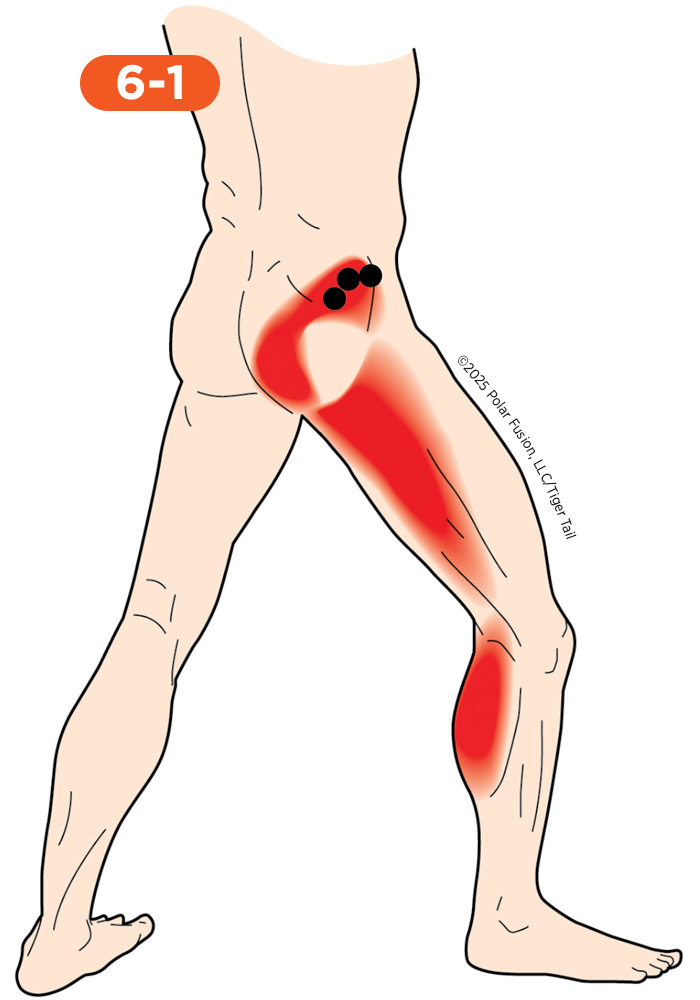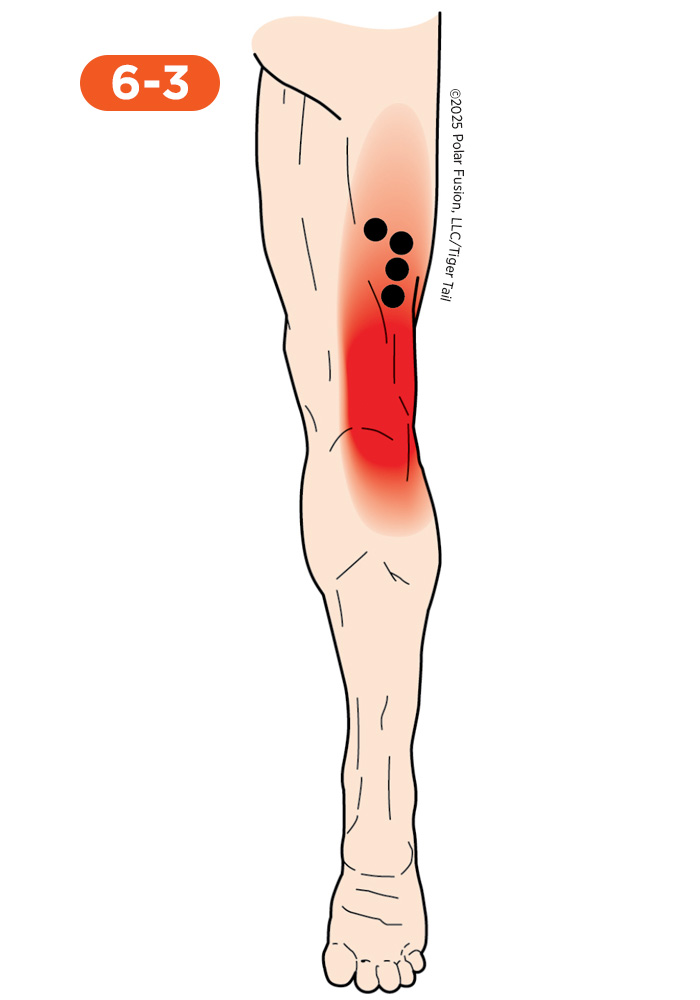Hamstring Pain
The hamstrings are the muscles located in the back of the thigh. There are three different muscles that make up the hamstring group and are responsible for extending the hip and bending or flexing the knee. Muscle knots in these muscles can cause pain in the back of the thigh, in the buttocks area, and the lower leg. Tight hamstrings can also cause lower back pain.

Causes
Sitting in a chair for extended periods of time: When you sit for hours on end, the muscles on the back of the thigh, or better known as the hamstring muscles, are stuck in a shortened position. Over time, this can lead to them becoming tight and stiff, often causing that familiar ache in your lower back or glutes when you finally stand up or try to extend your leg.
Poor flexibility: When your muscles are tight and can’t move through their full range, they often develop stubborn muscle knots. These little bundles of tension not only cause localized discomfort but can also lead to referred pain in other areas, making everyday movements a challenge and highlighting the importance of myofascial release and consistent stretching exercises for pain relief.

I Feel
Sciatica-like Symptoms
If you’re experiencing pain that feels like a nerve is being pinched, the source could be muscle knots in the outer part of the hip or the posterior portion of the gluteus minimus muscle. You could be feeling sciatica-like symptoms, which can feel like a shooting, burning pain that starts in your lower back or buttocks and travels down the back of your thigh and calf, sometimes even reaching your foot and toes. You might also experience tingling, numbness, or muscle weakness in the affected leg. It’s often described as feeling like an electric shock or pins and needles, and it can be aggravated by movements like bending forward, carrying a wallet in your back pocket, or sitting for too long. You’ll find the pain gets worse when you’re doing movements that stretch the buttocks, like sitting with crossed legs, bending over to pick something up, or stretching your hip into rotation. Because the muscle lies along the path of the sciatic nerve, it can easily mimic deeper nerve problems, such as true sciatica or piriformis syndrome.

I Feel
Sciatica-like Symptoms
That debilitating pain that feels exactly like sciatica is frequently caused by muscle knots in the deep buttock muscle, the piriformis. The discomfort usually focuses deep in the center of the buttock, presenting as a sharp, burning tingle that dramatically runs along the entire length of the back of your leg. You’ll notice the pain gets worse when you’re doing activities that compress the nerve, such as sitting on a hard surface, driving for long periods, or doing deep lunges. Because the sciatic nerve often passes right through or under this muscle, it can easily mimic an actual lumbar disc problem or herniated disc. The buttock tissue is susceptible to pressure, and it leaves the entire leg feeling weak and restricted, especially when you try to rotate your hip.

I Feel
Hamstring Pull
When you have what feels exactly like a hamstring pull near the knee, the source is often just tight muscle knots in the outer hamstring muscle, the biceps femoris. The discomfort usually focuses low on the back and outside of the knee, presenting as a sharp, intense tugging pain that feels like a strain during movement. You’ll find the pain gets worse when you’re doing activities that rapidly lengthen the muscle, like sprinting, bending over to touch your toes, or stepping out suddenly. Because the discomfort is so acute, its knotting can easily mimic deeper problems, such as an actual hamstring tear or popliteal tendinitis. The lower hamstring is often susceptible to pressure, and the muscle leaves the entire back of the leg feeling guarded and restricted, especially when attempting to straighten the knee fully.
Sciatica-like Symptoms
That confusing pain that feels like a nerve issue running down your leg can actually be muscle knots in the outer hamstring —the biceps femoris —mimicking sciatica. The discomfort usually focuses deep behind the knee, presenting as a deep, tight ache that can run along the outside of the calf. You’ll find the pain gets worse when you’re doing activities that put the muscle under tension, like bending over to tie your shoes, sitting with your leg elevated straight, or running downhill. Because tightness refers to pain along the leg’s nerve pathway, it can easily mimic deeper problems, such as true sciatica or peroneal nerve entrapment. The tissue is susceptible to pressure behind the knee, and it leaves the leg feeling tight and restricted, especially when trying to straighten the knee completely.
Lower Back Pain Due to Tight Hamstrings
When you blame your lower back pain on tight hamstrings, the specific culprit is often muscle knots in the outer hamstring, the biceps femoris. The discomfort usually focuses on the lower back near the Sacrum, presenting as a dull, pervasive ache that feels connected to the leg’s restriction. You’ll notice the back pain gets significantly worse when you’re doing actions that require forward folding, like bending over to load the dishwasher, toe touches, or sitting on the edge of a chair. Because the tight biceps femoris constantly pulls on your pelvis, it can easily mimic deeper problems like lumbar joint stiffness or sacroiliac (SI) joint pain. The hamstring tissue itself is susceptible to pressure, and it leaves the entire back of your body feeling stiff and restricted. Bending forward or even just standing for a while can sometimes aggravate this achiness, and you might notice it more around your beltline.
Dull Ache Behind Knee
That persistent dull ache behind the knee is a signature sign of muscle knots in the outer hamstring, the biceps femoris. The discomfort usually focuses directly on the soft area behind the knee, the popliteal space, and presents as a deep, chronic throb that occasionally feels like a strain. You’ll find the pain gets significantly worse when you do activities that repeatedly bend the knee, like cycling, long-distance driving, or deep squatting. These muscle knots can easily mimic deeper problems, such as popliteal tendinitis or a Baker’s Cyst. The area behind the knee is often susceptible to pressure, and the muscle can leave the knee feeling guarded and restricted, especially after activity.

I Feel
Hamstring Pull
When you have what feels exactly like a hamstring pull high up in the leg, it is often muscle knots in the inner hamstrings, the semitendinosus and semimembranosus. The pain and discomfort usually focus high up near the sitting bone (ischial tuberosity), presenting as a sharp, electric pulling pain that makes walking difficult. You’ll find the pain gets worse when you’re doing activities that rapidly lengthen the muscle, like sprinting, lifting your leg straight out in front of you, or deep bending. Because the discomfort is specific to the attachment point, its knotting can easily mimic deeper problems, such as an actual hamstring tear or tendinopathy. The high inside hamstring area is susceptible to pressure, and it leaves the hip and leg feeling guarded and restricted, limiting your ability to take a whole step.
Sciatica-like Symptoms
That pain that feels exactly like a nerve issue running down your leg can be muscle knots in the inner hamstrings, the semitendinosus and semimembranosus, and can mimic sciatica. The discomfort usually focuses deep in the inner thigh and buttock, presenting as a deep, burning ache that can run along the back of the knee and inner calf. You’ll find the pain gets worse when you’re doing activities that stretch the back of the leg, like bending over to touch your toes, sitting with your leg straight out, or deep hip flexion. Since tightness can follow the same nerve path down the leg, it often feels like something more serious, like true sciatica or piriformis syndrome, even when it’s not. You might also experience tingling, numbness, or muscle weakness in the affected leg.
